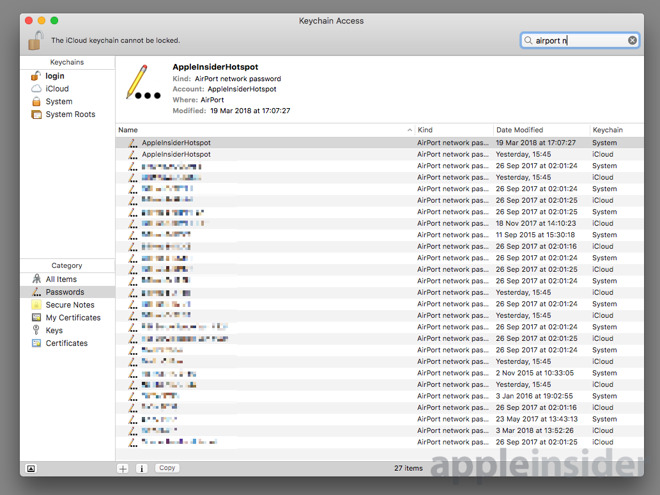A media access control address (MAC address) is a unique identifier assigned to a network interface controller (NIC) for use as a network address in communications within a network segment. This use is common in most IEEE 802 networking technologies, including Ethernet, Wi-Fi, and Bluetooth.Within the Open Systems Interconnection (OSI) network model, MAC addresses are used in the medium access. Find MAC Address Vendors. Enter a MAC Address // Features. Our list of vendors is provided directly from the IEEE Standards Association and is updated multiple times each day. The IEEE is the registration authority and provides us data on over 16,500 registered vendors.
The ability to switch between different sets of network settings (locations) can be useful in circumstances such as these:
- You use the same type of network (such as Ethernet) at work and at home, but the settings you use at work don't allow your Mac to automatically connect to the same type of network at home.
- Your Mac connects to more than one type of network service (such as both Wi-Fi and Ethernet) at work and at home, but at work you want your Mac to try connecting to the Ethernet network first, and at home you want your Mac to try connecting to the Wi-Fi network first. In other words, you want to set a different service order for each location.
- Your Mac isn't connecting to your network and you want to quickly reset your network settings for testing purposes, without losing your current network settings.
In each of these examples, the Location feature of Network preferences can help.
Wifi Looking For Networks Mac Os Sierra
- One of the things I am looking for is the Microsoft equivalent of the 'network center'. Everything works on my mac network-wise. However, I would like to see all devices in the network. For instance all my Sonos devices. If something is not working I was used to quickly open the network overview in Windows and see whether all devices where at.
- Download wifi look PC for free at BrowserCam. Mo-Link.com published the wifi look App for Android operating system mobile devices, but it is possible to download and install wifi look for PC or Computer with operating systems such as Windows 7, 8, 8.1, 10 and Mac.
How to add or remove a network location
- Choose Apple menu () > System Preferences, then click Network.
- The Location pop-up menu shows the name of your currently selected set of network settings. The default location is named Automatic. Choose Edit Locations from this menu.
- Click the Add (+) button below the list of locations, then type a name for the new location, such as Work or Home or Mobile. (To remove a location, use the Remove (–) button below the list.)
- Click Done. The Location menu should now show the name of your new location. Any changes you now make to your Wi-Fi, Ethernet, or other network settings will be saved to that location when you click Apply. The network settings in your previous location remain as you left them, so you can use the Location menu to switch back at any time.
- Click Apply to save your settings and complete the switch from the previous location to the new one. Your Mac then automatically tries to determine the correct settings for each type of network. If you need to change the settings manually, remember to click Apply again after making your changes.
How to switch between network locations
If you have more than one location, you can use either of these methods to switch between them:
- Use the Location pop-up menu in Network preferences, as described above. Remember to click Apply after choosing a location.
- Or choose Apple menu > Location from the menu bar, then choose your location from the submenu.
Why Does My Wifi Keep Looking For Networks Mac
How to change the network service order
If you're using network locations because you want each location to prefer a different network service (such as Wi-Fi or Ethernet) when connecting, follow these steps to change the service order (also known as port priority) in each location.
- Choose Apple menu > System Preferences, then click Network.
- Use the Location menu to choose the location you want to modify.
- Click below the list of services, then choose Set Service Order.
- Drag services within the list to change their order. Your Mac will try to connect to the service at the top of the list first, then continue in descending order until a connection is successful.
Virtual private network (VPN) connections can't be reordered, because they always take priority over other connections. - Click OK, then click Apply to make the updated service order active.

How to prevent a network service from being used
By default, the location named Automatic makes all available network services (also known as ports or network interfaces) active, whether or not they are being used to connect to a network. Your Mac automatically searches these services for a network or Internet connection. For example, you might use a Wi-Fi network at home but an Ethernet network at work. Your Mac automatically detects which of these network services to use when it connects.
If you want to make sure that your Mac doesn't use a particular network service, such as Wi-Fi, you can make that service inactive in any of your network locations:

Wifi Looking For Networks Mac Os Sierra
- Choose Apple menu > System Preferences, then click Network.
- Use the Location menu to choose the location you want to modify.
- Click below of the list of services, then choose Make Service Inactive.
- Click Apply.
Macbook Keeps Looking For Networks
Thanks for stopping by the Apple Support Communities. From your post, I understand that you have two MacBook computers (an Air and a Pro) that are having trouble connecting to Wi-Fi. You see on both devices that they are always looking for networks. I'm happy to help!
First, make sure you are taking the appropriate steps to connect to Wi-Fi: How to connect to the Internet with your Mac - Apple Support. If you are and still having trouble, I would recommend the steps in How to troubleshoot Wi-Fi connectivity - Apple Support.
If you still need additional help, please reach out to Apple Support directly for additional assistance: Contact Apple Support.
Have a great day.
